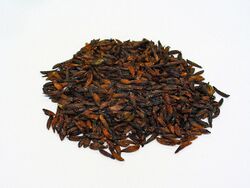Biology:Schoenocaulon officinale
From HandWiki
Revision as of 00:00, 30 July 2021 by imported>TextAI (over-write)
Short description: Species of plant in the genus Schoenocaulon
| Schoenocaulon officinale | |
|---|---|

| |
| Botanical illustration | |

| |
| Seeds | |
| Scientific classification | |
| Kingdom: | Plantae |
| Clade: | Tracheophytes |
| Clade: | Angiosperms |
| Clade: | Monocots |
| Order: | Liliales |
| Family: | Melanthiaceae |
| Genus: | Schoenocaulon |
| Species: | S. officinale
|
| Binomial name | |
| Schoenocaulon officinale (Schltdl. & Cham.) A.Gray[1]
| |
| Synonyms[2] | |
|
List
| |
Schoenocaulon officinale, called sabadilla, is a species of flowering plant in the genus Schoenocaulon, native to Mexico, Central America, and Venezuela.[2] It is highly toxic, containing veratridine, cevadine, and other alkaloids. Its seeds were used by pharmacists around the world to prepare delousing solutions and insecticides. It is still collected and used locally to rid domestic animals of fleas, ticks, lice and other parasites, and attempts are being made to revive the industry.[3]
References
- ↑ G.Bentham, Pl. Hartw.: 29 (1840)
- ↑ 2.0 2.1 "Schoenocaulon officinale (Schltdl. & Cham.) A.Gray". Board of Trustees of the Royal Botanic Gardens, Kew. 2017. http://powo.science.kew.org/taxon/urn:lsid:ipni.org:names:540614-1.
- ↑ Hare, J. Daniel (1996). "Purification and Quantitative Analysis of Veratridine and Cevadine by HPLC". Journal of Agricultural and Food Chemistry 44: 149–152. doi:10.1021/jf9406828.
Wikidata ☰ Q9332551 entry
 |

